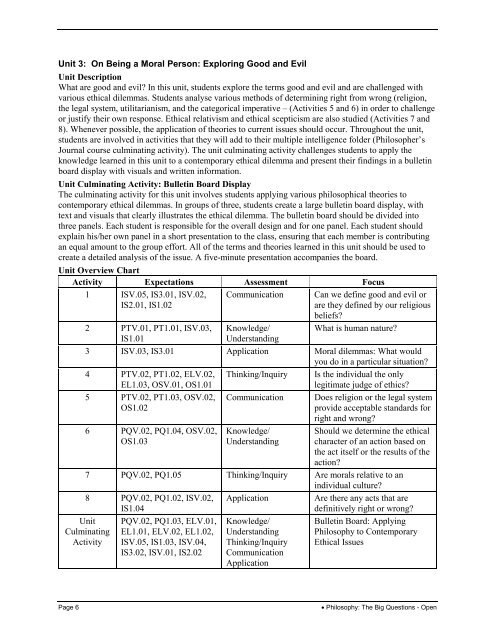Course Profile - Curriculum Services Canada
Course Profile - Curriculum Services Canada
Course Profile - Curriculum Services Canada
Create successful ePaper yourself
Turn your PDF publications into a flip-book with our unique Google optimized e-Paper software.
Unit 3: On Being a Moral Person: Exploring Good and Evil<br />
Unit Description<br />
What are good and evil? In this unit, students explore the terms good and evil and are challenged with<br />
various ethical dilemmas. Students analyse various methods of determining right from wrong (religion,<br />
the legal system, utilitarianism, and the categorical imperative – (Activities 5 and 6) in order to challenge<br />
or justify their own response. Ethical relativism and ethical scepticism are also studied (Activities 7 and<br />
8). Whenever possible, the application of theories to current issues should occur. Throughout the unit,<br />
students are involved in activities that they will add to their multiple intelligence folder (Philosopher’s<br />
Journal course culminating activity). The unit culminating activity challenges students to apply the<br />
knowledge learned in this unit to a contemporary ethical dilemma and present their findings in a bulletin<br />
board display with visuals and written information.<br />
Unit Culminating Activity: Bulletin Board Display<br />
The culminating activity for this unit involves students applying various philosophical theories to<br />
contemporary ethical dilemmas. In groups of three, students create a large bulletin board display, with<br />
text and visuals that clearly illustrates the ethical dilemma. The bulletin board should be divided into<br />
three panels. Each student is responsible for the overall design and for one panel. Each student should<br />
explain his/her own panel in a short presentation to the class, ensuring that each member is contributing<br />
an equal amount to the group effort. All of the terms and theories learned in this unit should be used to<br />
create a detailed analysis of the issue. A five-minute presentation accompanies the board.<br />
Unit Overview Chart<br />
Activity Expectations Assessment Focus<br />
1 ISV.05, IS3.01, ISV.02, Communication Can we define good and evil or<br />
IS2.01, IS1.02<br />
are they defined by our religious<br />
beliefs?<br />
2 PTV.01, PT1.01, ISV.03,<br />
IS1.01<br />
Knowledge/<br />
Understanding<br />
What is human nature?<br />
3 ISV.03, IS3.01 Application Moral dilemmas: What would<br />
you do in a particular situation?<br />
4 PTV.02, PT1.02, ELV.02,<br />
EL1.03, OSV.01, OS1.01<br />
5 PTV.02, PT1.03, OSV.02,<br />
OS1.02<br />
6 PQV.02, PQ1.04, OSV.02,<br />
OS1.03<br />
Thinking/Inquiry<br />
Communication<br />
Knowledge/<br />
Understanding<br />
Is the individual the only<br />
legitimate judge of ethics?<br />
Does religion or the legal system<br />
provide acceptable standards for<br />
right and wrong?<br />
Should we determine the ethical<br />
character of an action based on<br />
the act itself or the results of the<br />
action?<br />
7 PQV.02, PQ1.05 Thinking/Inquiry Are morals relative to an<br />
individual culture?<br />
8 PQV.02, PQ1.02, ISV.02,<br />
IS1.04<br />
Unit<br />
Culminating<br />
Activity<br />
PQV.02, PQ1.03, ELV.01,<br />
EL1.01, ELV.02, EL1.02,<br />
ISV.05, IS1.03, ISV.04,<br />
IS3.02, ISV.01, IS2.02<br />
Application<br />
Knowledge/<br />
Understanding<br />
Thinking/Inquiry<br />
Communication<br />
Application<br />
Are there any acts that are<br />
definitively right or wrong?<br />
Bulletin Board: Applying<br />
Philosophy to Contemporary<br />
Ethical Issues<br />
Page 6<br />
• Philosophy: The Big Questions - Open
















